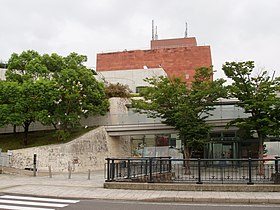Nagasaki Atomic Bomb Museum
 |
|
| Established | 1955, built current museum 1996 |
|---|---|
| Location | 7-8 Hirano-machi, Nagasaki, Nagasaki |
| Website | www1.city.nagasaki.nagasaki.jp/na-bomb/museum |
The Nagasaki Atomic Bomb Museum (長崎原爆資料館 Nagasaki Genbaku Shiryōkan) is in the city of Nagasaki, Japan. The museum is a remembrance to the atomic bombing of Nagasaki by the United States of America 9 August 1945 at 11:02:35 am. Next to the museum is the Nagasaki National Peace Memorial Hall for the Atomic Bomb Victims, built in 2003, which marks the hypocenter of the event. The bombing marked a new era in war, making Nagasaki a symbolic location for a memorial. The counterpart in Hiroshima is the Hiroshima Peace Memorial Museum. These locations symbolize the nuclear age, remind visitors of the vast destruction and indiscriminate death caused by nuclear weapons, and signify a commitment to peace.
The Nagasaki museum was completed in April 1996, replacing the deteriorating International Culture Hall. The museum covers the history of the event as a story, focusing on the attack and the history leading up to it. It also covers the history of nuclear weapons development. The museum displays photographs, relics, and documents related to the bombing.
The museum at the Nagasaki Peace Park replaced the Nagasaki International Culture Hall, where artifacts related to the bombing of Nagasaki were originally exhibited. These artifacts are now supplemented with photographs depicting daily life in Nagasaki before the atomic bomb was dropped, the devastation produced by the bomb, and the history of nuclear arms development.
The Nagasaki Atomic Bomb Museum covers the history of the bombing of Nagasaki, Japan. It portrays scenes of World War II, the dropping of the atomic bomb, the reconstruction of Nagasaki, and present day. Additionally, the museum exhibits the history of nuclear weapons development.
The atomic bomb was developed by scientists working under the Manhattan Project. The project was granted funding on December 6, 1941, with American leaders aiming for a new invention that would serve as a wartime weapon. The decision to drop an atomic bomb on Japan had been made by 1943, and a shortlist of candidate target cities was in place in 1945. At the time, it was argued that an atomic bombing would bring about a more rapid end to the war. Hiroshima, the first target, was selected to show the power of America's new weapon. The second bombing, of Nagasaki, was intended to demonstrate that the USA had a large arsenal. At 11:02 A.M. local time on August 9, 1945, the atomic bomb, nicknamed Fat Man after Winston Churchill, was dropped on Nagasaki, forever changing the city's landscape. A mushroom cloud rose to an altitude of 45,000 feet above the city.
...
Wikipedia
